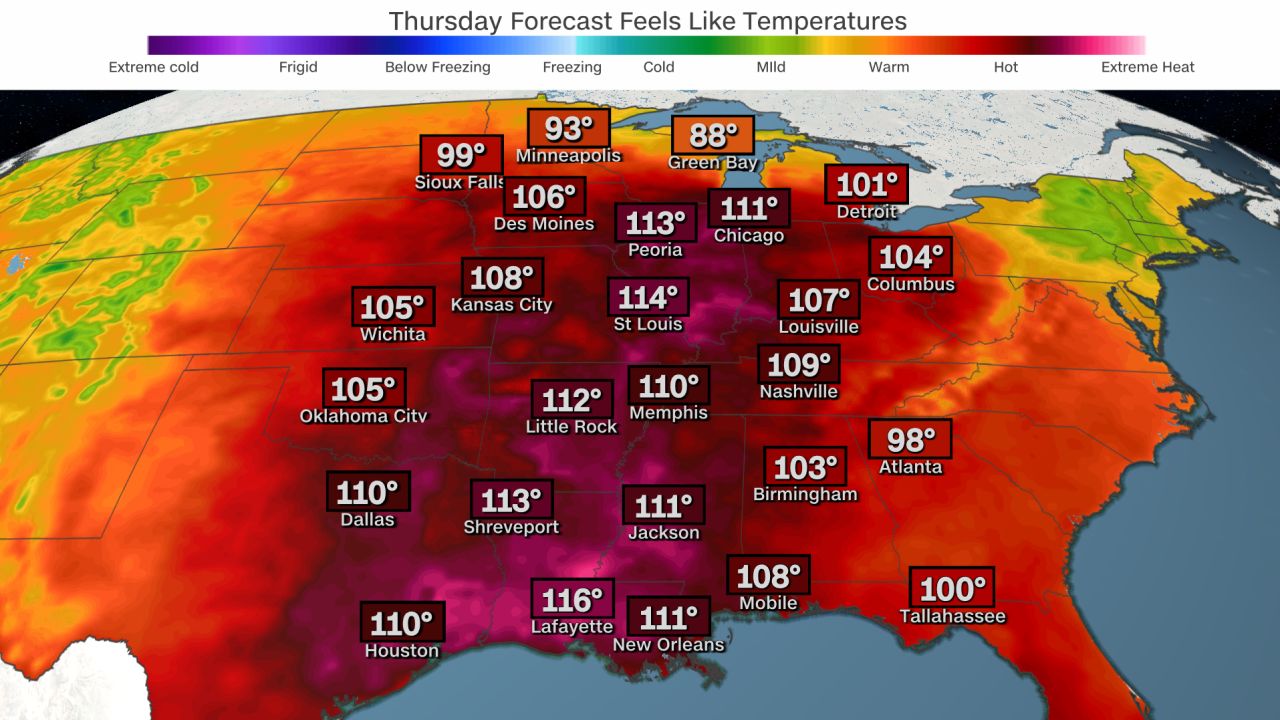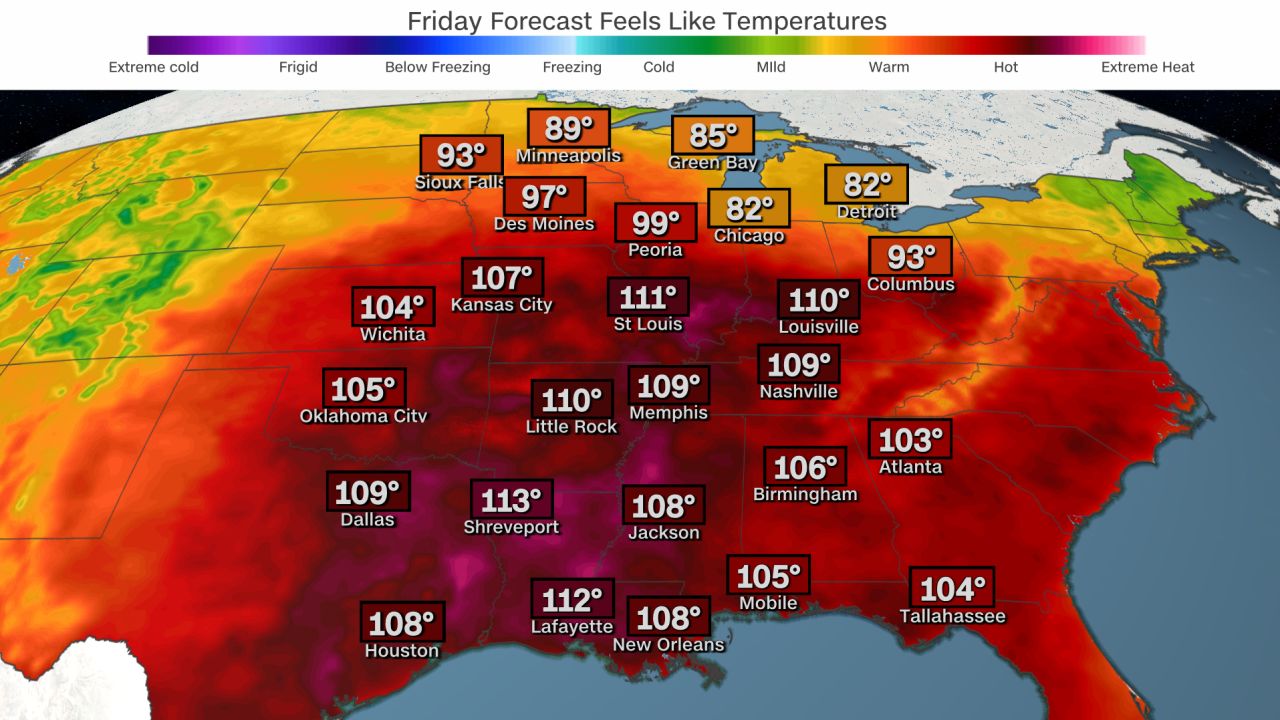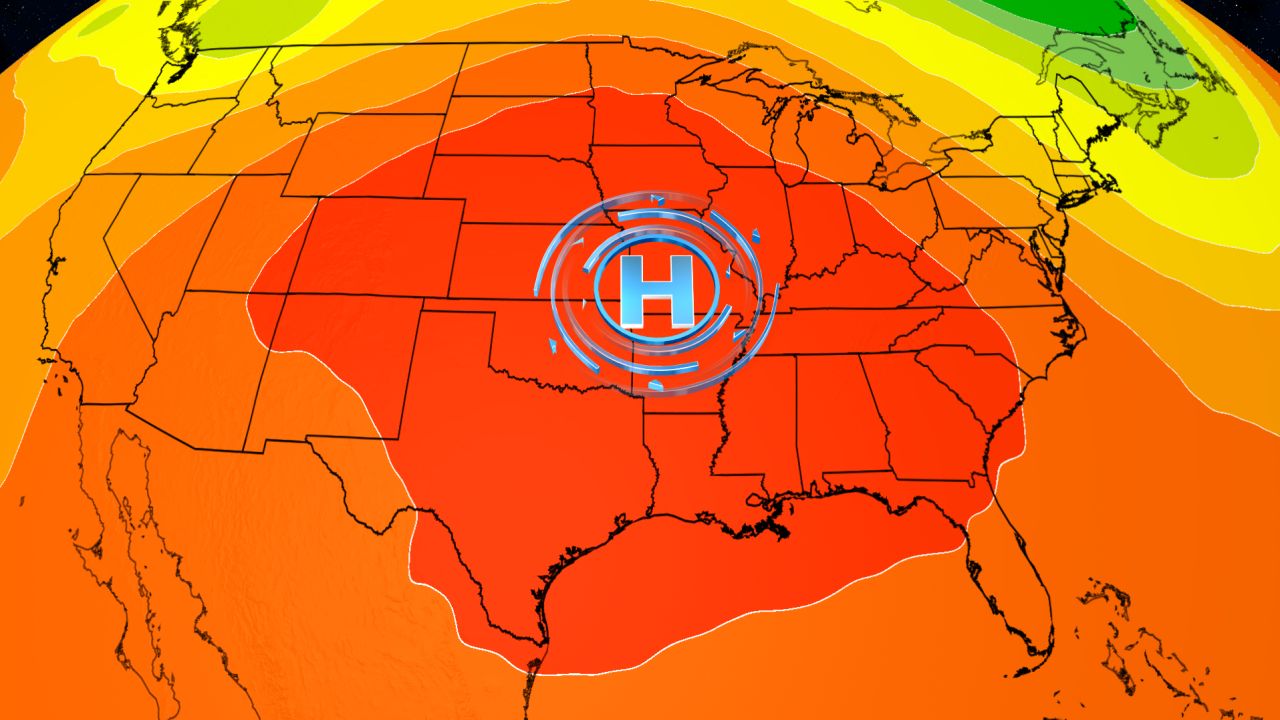CNN
—
Nearly two dozen cattle died in Nebraska, more than 100 Missouri nursing home residents were evacuated and an ice cream shop in Iowa was forced to close as record-shattering heat engulfs more than 20 states.
Excessive heat warnings, the most severe form of heat alert, spanned more than 1,100 miles Wednesday, from the Gulf Coast northward to central Minnesota. Twenty-two states were under some kind of heat alert Wednesday afternoon.
Temperatures will soar more than 20 degrees above what is typical for late August through the end of the week across the Plains, Midwest and South. Even locations that are acclimated to sweltering summer heat will face extreme conditions.
By Friday, more than 65 million people will have experienced a temperature above 100 degrees.
This latest heat wave is exceptional even for this record-breaking summer. It’s being fueled by a heat dome, a strong area of high pressure that traps and intensifies hot air at the surface, which has been measured at record levels in multiple states.
The dangerous heat forced the evacuation of 117 people at a Kansas City nursing home Tuesday after the air conditioning there failed, the Kansas City Fire Department said. The heat index reached 119 degrees. Seven of the residents were Covid-19 positive and taken to a hospital, KCFD Battalion Chief Michael Hopkins said.
The rest were relocated to nine other local facilities, Hopkins said.
The heat has also proved unsurvivable for some animals. Twenty-two cattle died in extreme heat Tuesday at a University of Nebraska-Lincoln farm according to Eric Hunt, an agricultural climatologist with University of Nebraska extension.
In Des Moines, Iowa, the Black Cat Ice Cream store closed through Thursday, with its owners writing in a Facebook post the “extreme heat is too much for the 100+ year old building that we are in to keep up.”
And the temperatures won’t let up: Hundreds of heat records could be set in the coming days as portions of the central and southern US approach temperatures never-before recorded.
Scroll down for a day-by-day look at the heat forecast.
The core of the worst heat on Wednesday is centered along the Mississippi River Valley and impacts states as far north as Minnesota, Wisconsin and Illinois.
Multiple Midwestern cities including Chicago, Indianapolis and Springfield, Illinois, may reach triple digits on Wednesday for the first time in over a decade.
The heat index already exceeded 100 degrees early Tuesday afternoon as far north as Minneapolis and Green Bay, Wisconsin. These cities typically experience temperatures in the 70s in late August. Chicago’s heat index climbed to 116 degrees early Tuesday afternoon, which was just short of the city’s all-time record of 118 degrees set on July 14, 1995.
On the southern end of the heat dome, New Orleans will make a run Wednesday at reaching or exceeding it highest temperature ever recorded – 102 degrees. The city will only add to a recorded 12 days of temperatures at or above 100 degrees this year, which is more than any other year on record.

Portions of the Midwest and Plains will begin to see minor relief on Thursday as the worst of the heat starts to shift south and eastward. Scorching heat will remain in place across the South and much of the Mississippi River Valley, but will expand east to roast the Ohio Valley and more of the Southeast.
Record high temperatures may fall from Iowa to Indiana and southward to the Gulf Coast on Thursday.
The heat index in parts of Michigan, Ohio and West Virginia could climb into the triple digits on Thursday after being spared from the worst of the heat for several days this week.

Friday is shaping up to be yet another brutal day for the southern US, with dozens of records in jeopardy from Texas to the Carolinas.
Georgia and portions of the Carolinas will experience heat index values in excess of 100 degrees, while parts of Louisiana continue to deal with values in the 110s.
Overnight temperatures won’t fall to levels more typical for late August and will be dangerously high. Elevated overnight temperatures can pose a serious risk to people without a reliable way to cool off.

The ongoing heat dome has been the strongest on record in several locations, including portions of Kansas, Nebraska and Missouri according to the National Weather Service offices there.
A weather balloon launched Monday by the National Weather Service office in Topeka, Kansas, observed atmospheric data that would suggest this heat dome is record-strong for that location. The same was true in Lincoln, Nebraska, and Springfield, Missouri.
The heat index topped 130 degrees in Kansas on Sunday and Monday and reached a staggering 134 degrees on Monday in Lawrence. It also topped 120 degrees on Tuesday in several states including Missouri, Kansas and Oklahoma.
Milwaukee Public Schools are closed Wednesday as an excessive heat warning remains in effect for the area, the school district said. All after-school activities, athletics, recreation child care camps, community learning centers and Safe Places are also canceled or closed for the day.
The district announced schools will remain closed Thursday and all after-school and athletic programs are canceled.
In Missouri, Kansas City Public Schools will release students early for the rest of this week as some of its classrooms don’t have air conditioning units. The heat index in the area could hit 110 degrees.
“It’s important to note that many of our secondary schools don’t have AC units in all of the classrooms, and the existing AC units are struggling due to this unusual heat, and are not able to maintain a comfortable temperature within our facilities,” the Kansas City school district said.
In Iowa, 100% of Des Moines Public Schools’ classrooms do have air conditioning – and the AC “has been running around the clock to best maintain comfortable indoor temperatures,” the school district said.
However, “Most school buses are not air conditioned; riders should expect these vehicles to be warm throughout the day,” Des Moines Public Schools said.
And some schools from Chicago to Omaha, Nebraska, have canceled outdoor activities until the extreme heat ends.